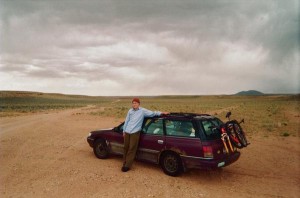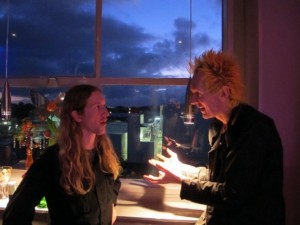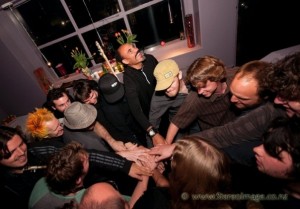The music video for the single Push On Thru features a 1993 Saab 900 cruising on snowy rural roads in the New Zealand countryside. Listen to album + watch.
I could relate to the way the video showed winter’s sky, farm animals on dirt roads, and music blasting out rolled down windows down with the heat turned up. I know November’s internal cold feeling, and like damp freezing rain, the bass from Push On Thu sunk deep inside + lingered. As a 20 year old with a 5-speed Subaru and a pair of Pioneer speakers, I sought after seasonal roads, frost heaves, snowpack, and power turns. Inside The Dub Plates become the soundtrack I remember most during gray winter drives.
Looking back at the album today- a few things stand out:
#1 Sal Dub’s bass reminds me of Nate Edgar’s (John Brown’s Body) low turbo bass, especially on songs Problems, Platectonics, Push On Thru, Tui Dub.
#2 The horn section maintains an integrity that to this day I associate with New Zealand music. For Example the horns always have strong legs on recordings from The Black Seeds, Fat Freddy’s Drop, and Sal Dub.
#3 Paddy Free who co-produced Inside The Dub Plates and Jocko who co-produced Amplify by John Brown’s Body look like intense audio brothers when they stand together.
Photo’s by Chris Gee (Auckland 2009)
Have a listen to Inside The Dub Plates from Salmonella Dub:
Further Reading-
Below is a bio written about Salmonella Dub in 2007. We all search for stories to share about a band, a recording, or anything (cough, cough…cabins in the woods) to cut through to the press. This bio by Jody Macgregor meets all expectations, and then some.
– Seth
– – – –
Salmonella Dub got their name from the “bad-taste” dub versions of popular songs they used to break the ice in their early sets. In ’90s New Zealand, dub/roots/reggae freak-outs weren’t entirely in vogue — grunge and dance music held sway — so Salmonella Dub would use lighthearted covers of Nancy Sinatra and Dr. Hook & the Medicine Show tunes or Fred Dagg’s novelty song “Larry Loves Barry” to win over skeptical audiences.
In the early ’90s, New Zealand’s liquor licensing laws changed, allowing pubs and clubs to stay open late and revitalizing the country’s live music scene. The members of the band then called Golf Course Alligators seized this opportunity and, in late 1992, Andrew Penman (guitar), Mark Tyler (bass), and Dave Deakin (drums) became Salmonella Dub. In the early days they lacked money for proper equipment and used inventive solutions such as creating a sampler by hooking up a cassette player to a switch pedal from Penman’s guitar so they could create live samples. Usually these samples would come from whatever was on the TV at the time, whether it was the news or a Cheech & Chong movie. Lacking the funds for cassettes, they raided the bins of a record store and found discarded copies of Teenage Mutant Ninja Turtles albums that served as their early tape stock.
To prepare for their first, self-titled album in 1994, Peter Woods (trumpet, keyboard) and Conan Wilcox (saxophone, percussion) were invited to join the band. Salmonella Dub was released through the independent label Curious Records.
Soon afterwards, Woods left the band, moving to Auckland and getting a job to pay his student overdraft. Tiki Taane (acoustic guitar, percussion) joined in his stead and in 1997 they released Calming the Drunken Monkey, signing with Virgin for distribution and beginning overseas tours.
In 1998 they released “For the Love of It,” a single that found a surprising degree of mainstream success and won them their first place in the Top Ten of the local charts. The album Killer Vision followed it and was also popular, achieving double platinum sales and being released in five countries. Suddenly they were local heroes, but based on an album with which they were personally unhappy and which they disliked having to play on the intensive touring that followed it.
For their 2001 album Inside the Dub Plates, they brought back David Wernham, who had been engineer on their initial releases before leaving to work with rock band Shihad, hoping to re-create their earlier sound. The album also went double platinum in sales. A remix album called Outside the Dubplates followed, including a remix by one of their heroes, Mad Professor, who had also done a mix of “For the Love of It.”
Facing an unexpectedly hefty tax bill in 2003, the band returned to the studio to quickly record their fifth album, One Drop East, to pay it off. Woods was brought back as a session musician and another Mad Professor remix was planned, but in the rush to release, it had to be left off and used instead on their next release, 2004’s Mercy. Mercy consisted of songs from the One Drop East recording sessions, mixed at a more leisurely pace.
Taane left to record a solo album and Woods was brought back as a full-time bandmember for recording sessions at a studio on Penman’s isolated rural property. The result was their seventh album, 2007’s Heal Me.



